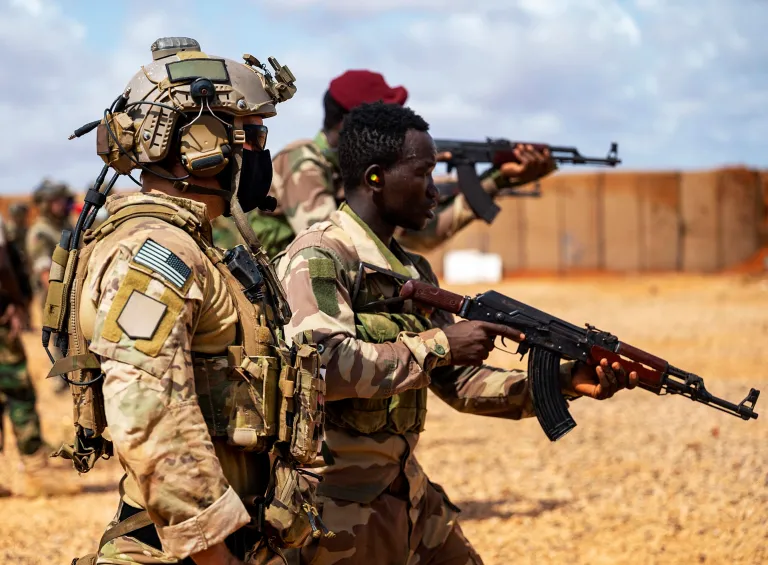US Troops in Somalia Rise to 900, House Votes Not to Withdraw
TRANSCEND MEMBERS, 8 May 2023
Ann Garrison | The Grayzone – TRANSCEND Media Service
The presence of US troops in Somalia helps the Islamist insurgency Al Shabaab recruit, exacerbating the very violence they claim to be fighting. But the House has voted down a resolution to withdraw.
3 May 2023 – On April 27, the House voted 101-321 against Republican Rep. Matt Gaetz’s resolution to remove all US troops from Somalia, even as all signs point to escalation in the fight with Al-Shabaab. AFRICOM, the US Africa Command, and Somalia’s president, Hassan Sheikh Mohamud, are both asking for more US presence, more funds, more weapons, more drones, and fewer restrictions on how they’re used.
The resolution did not call for an end to the drone bombing, only for the withdrawal of US troops.
Gaetz had no expectation that it would pass, but he forced all 435 members of the House to go on record for or against another costly US “forever war.” Conceivably they’ll have to answer for their votes in 2024, perhaps to the US’s tiny antiwar community, but more likely to the “America First” political movement that Gaetz shares with Donald Trump.
The vote ensures that the US will maintain a military presence in Somalia until at least after the next election cycle. At least 900 US troops have been stationed in Somalia, playing an advisory role while the national army they train takes heavy casualties on the battlefield against the Islamist al-Shabaab forces.
Located in the strategically significant Horn of Africa, Somalia not only has the longest coastline in Africa, but perhaps the world’s largest untapped coastal oil reserves. In 2021, the Somali government signed a $7 million oil exploration deal with the Houston, Texas-based company, Coastline.
Though congressional hawks justify the US military presence in Somalia in terms of “freedom” and counter-terrorism, the country’s geography and potentially massive oil wealth make it a key strategic prize for Washington.
Gaetz and the co-sponsors of the resolution to withdraw from Somalia were all Republicans. Fifty-two Republicans and 50 Democrats voted in favor of a pullout, while 165 Republicans and 156 Democrats voted no. (12 House members did not vote). The vote closely resembled the results on Gaetz’s failed resolution to withdraw from Syria, which brought together a left-right coalition in support while the bipartisan pro-war majority expressed vehement opposition.
In his press release, Gaetz wrote, “When the House debated my resolution to withdraw troops from Syria, both Republicans and Democrats argued the 2001 Authorization for Use of Military Force (AUMF) against Afghanistan serves as a global permission slip for every neocon fantasy. They will argue the same for Somalia.” As they did, although some said it should be revisited and rewritten with a narrower scope.
JUST NOW: @RepMattGaetz Calls for Urgent Removal of U.S. Troops from #Somalia, Supports War Powers Resolution.
Gaetz, a member of House Armed Services Committee, argued that the presence of American troops in Somalia is not only ineffective in achieving its goals, but also… pic.twitter.com/cBG99xnXWT
— Simon Ateba (@simonateba) April 27, 2023
Somali President Hassan Sheikh Mohamud is all in
Most reports are likening Gaetz’s resolution to withdraw from Somalia to the effort he previously led to force a US military pullout from Syria. But there is a key distinction between the two situations.
In Syria, US troops are violating international law because they are not welcome by the government in Damascus. They are an occupying force violating Syrian sovereignty.
In Somalia, however, President Hassan Sheikh Mohamud is all in with US drones in the air and troops on the ground, tweeting his thanks to Joe Biden. His only complaint has been that he’s not getting enough air support.

The US shoehorned Mohamud into power in May 2022 by using the IMF to batter Somalia into holding a corrupt, clan-based election. They now have a willing collaborator whom many Somalis consider to be their puppet.
Moreover, anti-American sentiment is widespread, and the US presence serves as a recruiting tool for Al-Shabaab. On the same day the House voted not to withdraw troops, Brown University’s Costs of War Project reported, “The United States says its goals in Somalia are to eliminate Al-Shabaab and promote peace. The paper documents how U.S. counterterrorism policies are having the opposite effect and ensuring that the conflict continues in perpetuity.” It concluded that Al-Shabaab is still on the rise 16 years after its emergence, and noted, “The U.S. spends more on counterterrorism in Somalia each year than the Federal Somali Government earns in tax revenue.”
Al-Shabaab arose in response to the US-backed Ethiopian invasion of Somalia, when Ethiopia was led by a longtime US client, the Tigray People’s Liberation Front (TPLF). The TPLF overthrew Somalia’s Islamic Courts Union and occupied the country from 2006 to 2009, while Al-Shabaab flourished in an atmosphere of national resistance. Thus, as TJ Coles documented for The Grayzone, the US is now fighting the very ‘terrorists’ it created.
Al-Shabaab took an oath of allegiance to Al Qaeda, but its connection is more ideological than operational.
Mission creep
President Donald Trump increased drone bombing but withdrew nearly all 700 US Special Forces in Somalia at the end of his term, in December 2020.
On May 16, 2022, the day after President Hassan Sheikh Mohammed was re-elected, President Joe Biden signed off on a Pentagon proposal to reintroduce troops and establish a “small persistent presence.” “We’re working now to evaluate local conditions, including those following the Somali presidential election yesterday,” said Pentagon Press Secretary John Kirby in a Defense Department press release. “And we’re engaging partners in the region, including the Somali government, to determine the best way forward.”
On the same day, the New York Times reported that the decision would “revive an open-ended American counterterrorism operation that has amounted to a slow-burn war through three administrations.” The Times also reported that “people familiar with the matter” said the number of troops would be capped at 450.
Now, roughly a year later, during the April 27 debate about the resolution to withdraw troops from Somalia, Gaetz and Congressman Ryan Zinke, R-Montana, each stated that there are about 900 US troops in Somalia. Gaetz serves on the House Armed Services Committee, Zinke on Military Construction, Veterans Affairs, and Related Agencies, an Appropriations Subcommittee, so they would be perfectly positioned to know.
Zinke, a former Navy Seal, argued for further escalation by invoking the Hollywood action blockbuster, Black Hawk Down, which dramatized the botched and bloody US military-humanitarian intervention in Mogadishu in 1993.
“Thank you, Mr. Chairman, I rise in opposition. But I agree with my distinguished colleagues from Florida that Congress has an obligation to review it. Congress should not abrogate our responsibility. We should ask the tough questions. And ultimately, we should provide the funding necessary and the resources to win. That’s our job.
“And I agree with you 100%. But as a commander, they are doing more than just guarding an embassy. A force structure of 900 may seem like a large footprint. But those of us who remember Black Hawk Down would suggest otherwise. A force requires medi-vac. Those medi-vac require people that service those aircraft.
“In case we get in trouble, we need a quick reaction force, a force large enough to defend our troops. Because I, unlike my colleagues, know that if you were to put any American servicemen in harm’s way, we want to ensure we have the adequate force to make sure they’re recovered safely.
“They also have to be fed. Communications. In order to have an effective force, you need a footprint that can do its mission. . . . “
When service members with the skill sets that Zinke listed are added to the 900 US Special Forces figure, the total number of troops could be in the thousands.
The Special Forces are already supported by a fleet of US Navy ships off Somalia’s coast, in the Gulf of Aden, the Arabian Sea, and the Indian Ocean, and additional troops at the US military base in neighboring Djibouti.
Support for Somaliland secessionists
The Biden administration has been tacitly supporting the secessionist movement in Somalia’s northern Somaliland State, seemingly in exchange for a military base site in the coastal city of Berbera. The plan to work directly with Somaliland—bypassing the Somali government—to establish the base in Berbera is outlined in the 2023 National Defense Appropriation Act (NDAA).
The plan, however, suffered a major setback when a brutal war broke out between Somaliland secessionists and unionists in the city of Las Anod and the surrounding region of Sool, Sanaag, and Cayn (SSC). Many died, many more were injured, and more than 200,000 may be displaced in the ongoing conflict.
The secessionist militias are on the outskirts of Las Anod, periodically shelling the city with artillery, and residents anticipate more violence after a Ramadan lull.
US and EU officials asked Somaliland officials to withdraw from the SSC Region, but merely expressed “disappointment” when they did not.
US props up unpopular president
As the US promotes the division of Somalia, it is propping up the corrupt and nominally functioning national government of President Hassan Sheikh Mohamud, which has no popular support inside or outside the capital of Mogadishu. US Brigadier General Peter Bailey issued a revealing set of comments to NBC, stating that Somalis “need democratic reform to make sure the government is recognized as being legitimate.”
Shortly after returning to power, Mohamud “declared total war” on Al-Shabaab, bidding for a new influx of support from the US and promising a quick victory.
However, nearly a year later, Al-Shabaab still controls large swathes of land, mostly in central and southern Somalia, through a combination of brute force, racketeering, and sheer terror. Control of contested areas seesaws with dizzying frequency.
One of Mohamud’s key strategies proved to be a spectacular failure. He armed clan militias in central Somalia, claiming to empower local resistance. Some then set up roadblocks to collect illegal taxes in Middle Shabelle, while others converged on Mogadishu to challenge his own authority. He responded, comically, that he would ban machine guns mounted on vehicles and rocket propelled grenades—weapons that he had distributed—in the streets of Mogadishu.
The strategy of infusing clan politics into the Somali National Army (SNA) led to high casualties and low morale. Many were killed after being lured into remote towns and running out of ammunition.
Among the high-profile casualties was the commander of Danab, meaning “Lightning,” an elite, US-trained commando brigade. The US has spent 80 million dollars to train, equip, feed and pay salaries for Danab. Bancroft Global, a private contractor for the State Department, vets and recruits its members.
The casualty rate is much higher in other branches of the SNA. Many deserted at a faster rate than they can be replaced.
Casualties and desertion have made the SNA a largely spent force.

US takes direct control of Somalia’s operations
Washington insists that Somalia is leading the war against Al-Shabaab, while the US is simply training and assisting its armed forces. However, a series of recent events demonstrate that the US is fully in charge of operations.
Ambassador Larry André, a foreign service veteran, orchestrates from within Mogadishu’s Halane, a sprawling and heavily fortified compound like the Green Zone in Iraq. In February, André arranged public relations offensives by embedding New York Times and NBC reporters with US Special Forces to produce pieces about the conflict.
The New York Times confirmed that Somali forces have been taking heavy casualties in recent months. Times correspondent Eric Schmitt described a graduation ceremony for new recruits of Danab, which was shrouded in sadness because the brigade had sustained heavy losses. “Many of the recruits will be rushed to the frontlines to backfill two Danab battalions decimated by an Al-Shabaab attack last month that left more than 100 soldiers dead or injured.”
While public relations led by the US Embassy in Mogadishu was kicking into high gear, the State Department convened a meeting in Washington, DC that included the UK, the United Arab Emirates, Qatar, and Turkey. The meeting took place on February 28, 2023. Among the agenda items was America’s request that its partners shoulder some of the financial burden of the prolonged war.

Also, on February 28, 2023, the US Embassy announced that it was sending 60 tons of new weapons and ammunition to Baledogle—in a pair of C-17 Globemaster cargo planes—to be used against Al-Shabaab.
On March 1, 2023, President Mohamud’s National Security Advisor, Hussein Sheikh-Ali, announced that Ethiopia and Kenya would be sending 30,000 more troops to help Somalia fight Al-Shabaab.
On March 29, 2023, President Joe Biden nominated Richard H. Riley to replace Larry André. Riley has served in significant positions in Pakistan, Norway, Afghanistan, Yemen, Egypt, and Iraq.
All these recent developments promise escalation and the likelihood of more US boots on Somali soil.
_______________________________________________
 Ann Garrison is an independent journalist based in the San Francisco Bay Area. She attended Stanford University and is a member of the TRANSCEND Network for Peace Development Environment. In 2014 she received the Victoire Ingabire Umuhoza Democracy and Peace Prize for her reporting on conflict in the African Great Lakes region. She can be reached at @AnnGarrison, ann@kpfa.org, ann@anngarrison.com.
Ann Garrison is an independent journalist based in the San Francisco Bay Area. She attended Stanford University and is a member of the TRANSCEND Network for Peace Development Environment. In 2014 she received the Victoire Ingabire Umuhoza Democracy and Peace Prize for her reporting on conflict in the African Great Lakes region. She can be reached at @AnnGarrison, ann@kpfa.org, ann@anngarrison.com.
 Jamal Abdulahi is a Somali American Software Engineer and writer based in Minneapolis. He is currently CEO of a digital healthcare firm dedicated to increasing access in historically disadvantaged communities. His work has appeared in many publications, including the Minneapolis Star Tribune & LA Times. He can be reached on Twitter @fuguni.
Jamal Abdulahi is a Somali American Software Engineer and writer based in Minneapolis. He is currently CEO of a digital healthcare firm dedicated to increasing access in historically disadvantaged communities. His work has appeared in many publications, including the Minneapolis Star Tribune & LA Times. He can be reached on Twitter @fuguni.
Go to Original – thegrayzone.com
Tags: Africom, Direct violence, Pentagon, Somalia, Structural violence, Terrorism, US Military, USA, Warfare
DISCLAIMER: The statements, views and opinions expressed in pieces republished here are solely those of the authors and do not necessarily represent those of TMS. In accordance with title 17 U.S.C. section 107, this material is distributed without profit to those who have expressed a prior interest in receiving the included information for research and educational purposes. TMS has no affiliation whatsoever with the originator of this article nor is TMS endorsed or sponsored by the originator. “GO TO ORIGINAL” links are provided as a convenience to our readers and allow for verification of authenticity. However, as originating pages are often updated by their originating host sites, the versions posted may not match the versions our readers view when clicking the “GO TO ORIGINAL” links. This site contains copyrighted material the use of which has not always been specifically authorized by the copyright owner. We are making such material available in our efforts to advance understanding of environmental, political, human rights, economic, democracy, scientific, and social justice issues, etc. We believe this constitutes a ‘fair use’ of any such copyrighted material as provided for in section 107 of the US Copyright Law. In accordance with Title 17 U.S.C. Section 107, the material on this site is distributed without profit to those who have expressed a prior interest in receiving the included information for research and educational purposes. For more information go to: http://www.law.cornell.edu/uscode/17/107.shtml. If you wish to use copyrighted material from this site for purposes of your own that go beyond ‘fair use’, you must obtain permission from the copyright owner.
